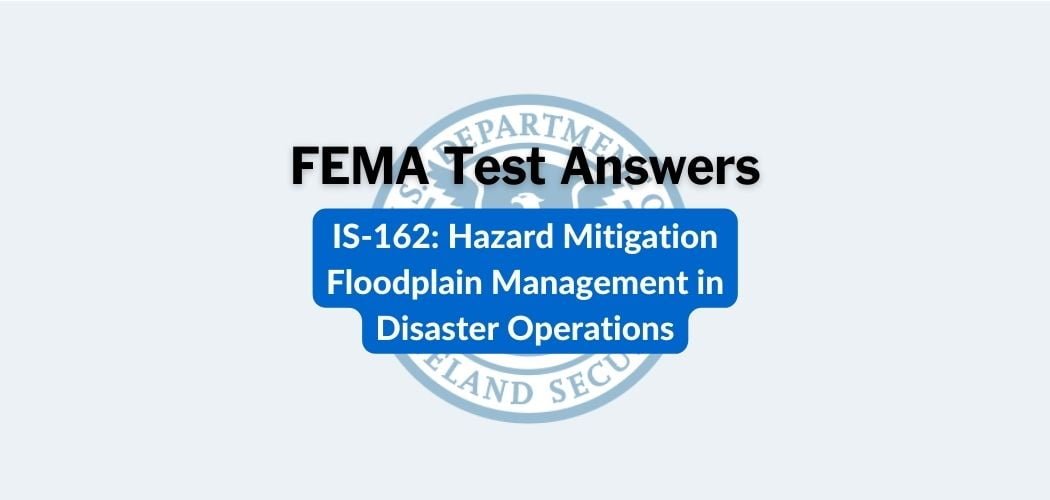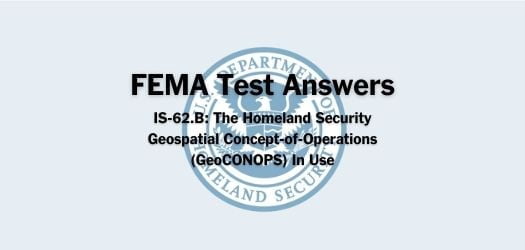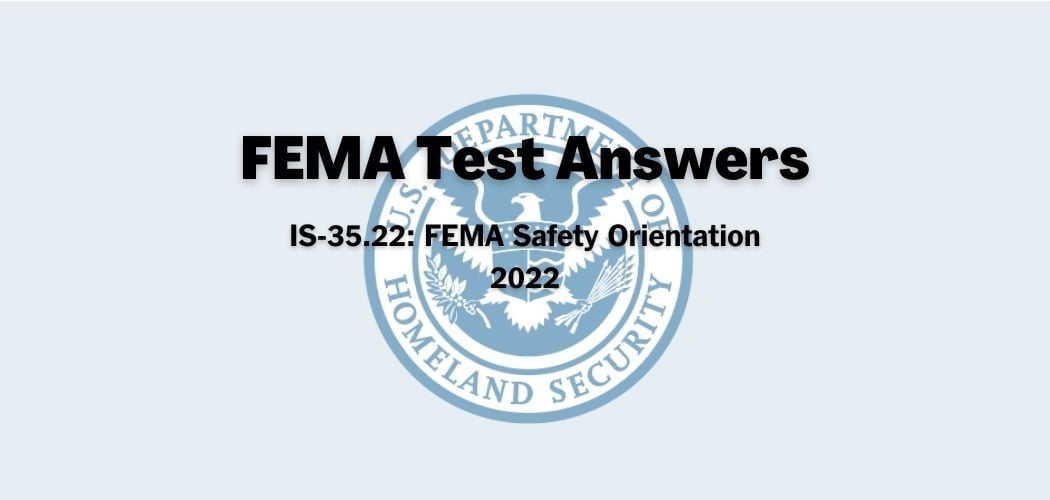Overview: The FEMA IS-633 course was published on 4/6/2017 to familiarize students with the concepts of a debris management plan and the process and components involved in developing a comprehensive debris management plan.
Primary audience: FEMA IS-633 is for SLTT governments with the intention of explaining the importance of a debris management plan, and describing the debris management plan development process.
FEMA IS-633 test answers
Each time this test is loaded, you will receive a unique set of questions and answers. The test questions are scrambled to protect the integrity of the exam.
Question 1. This law requires an assessment of the effects of debris removal projects on historic properties:
A. Coastal Barrier Resources Act
B. Endangered Species Act
C. Resource Conservation and Recovery Act
D. National Historic Preservation Act✅
Question 2. A _______ contract is a lump sum, unit price, or time and materials contract with a fixed contractor fee added to the price.
A. Unit price
B. Lump sum
C. Cost plus fixed fee✅
D. Time and materials
Question 3. A _______ contract is for work within a prescribed boundary with a clearly defined scope and a total price.
A. Unit price
B. Lump sum✅
C. Cost plus fixed fee
D. Time and materials
Question 4. Some debris management-related activities such as debris clearance, collection, reduction, and recycling can be accomplished through _______ services.
A. volunteer
B. contracted✅
C. human
D. social
Question 5. A jurisdiction may remove debris from private property on a voluntary or involuntary basis on the part of the property owner:
A. TRUE✅
B. FALSE
Question 6. Temporary debris management sites should not be considered if adequate landfill space is available in the jurisdiction.
A. TRUE✅
B. FALSE
Question 7. This law includes requirements regarding the discharges of pollutants into the waters of the United States:
A. Coastal Barrier Resources Act
B. Endangered Species Act
C. Resource Conservation and Recovery Act
D. Clean Water Act✅
Question 8. Debris on private property does not typically present an immediate health and safety threat to the general public.
A. TRUE✅
B. FALSE
Question 9. A gated community is an example of private property:
A. TRUE✅
B. FALSE
Question 10. This functional area develops staff schedules and strategies and creates a demolition strategy for structures if necessary.
A. Administration
B. Operations✅
C. Debris Project Manager
D. Planning/Engineering
Question 11. Determining the design disaster event and assumptions during the debris management planning process will assist with defining:
A. The debris management team leader.
B. Public Assistance regulations.
C. Resources needed.✅
D. The anticipated date of a disaster event.
Question 12. Criteria to consider when prioritizing which areas or corridors will be cleared first include:
A. Population density
B. Location of important facilities (schools, nursing communities, etc.)
C. Environmental justice issues (predominantly minority neighborhoods, lower-income neighborhoods, etc.).
D. All of the above✅
Question 13. Debris removal from private property is generally the responsibility of:
A. The jurisdiction
B. Volunteer groups
C. The State
D. The property owner✅
Question 14. For federal funding considerations, this type of contract may be used only after a determination that no other contract type is suitable:
A. Piggyback contracting
B. Time and materials contract✅
C. Cost plus percentage of cost contract
D. Contracts with debarred contractors
Question 15. Environmental permits and land-use variances may be required to operate disposal facilities:
A. TRUE
B. FALSE✅
Question 16. Sources of information for the development of the debris management plan should be restricted to people within the jurisdiction.
A. TRUE✅
B. FALSE
Question 17. Which of the following factors determines the size of a temporary debris management site:
A. The existence of fencing around the site
B. The cost of renting the site
C. The projected quantity of debris to be managed at the site✅
D. The location of fire protection services in the area
Question 18. This type of debris may be contaminated with pollutants from flooded sewage treatment plants, pesticides, herbicides, and other chemicals:
A. Household hazardous waste
B. Animal carcasses
C. Sandbags✅
D. Construction and demolition
Question 19. The debris management plan should identify potential permits that may be required and include procedures for obtaining them.
A. TRUE✅
B. FALSE
Question 20. This debris site environmental consideration includes videotaping or photographing the site:
A. Periodic environmental sampling
B. Baseline data collection✅
C. Reporting
D. Site closure
Question 21. For federal funding considerations, no Federal funding can be awarded for work completed:
A. Piggyback contracting
B. Time and materials contract
C. Cost plus percentage of cost contract
D. Contracts with debarred contractors✅
Question 22. Demolition of private structures following a disaster is usually based on health and _______ codes.
A. Traffic
B. Privacy
C. Safety✅
D. Occupation
Question 23. Environmental permits and land-use variances may be required to conduct reduction and recycling activities:
A. TRUE✅
B. FALSE
Question 24. Examples of specific debris management topics covered by public information include segregation of debris types and debris drop-off locations:
A. TRUE✅
B. FALSE
Question 25. Which of the following is an example of criteria to consider for debris removal priorities:
A. Percentage of owner-occupied homes in an area.
B. Previous damage to an area.
C. Environmental justice issues.✅
D. Areas covered by insurance.
Question 26. This law requires safe disposal of waste materials and promotes the recycling of waste materials:
A. Coastal Barrier Resources Act
B. Endangered Species Act
C. Resource Conservation and Recovery Act✅
D. National Historic Preservation Act
Question 27. Which of the following is an example of private property:
A. City hall
B. Mobile home park✅
C. State university
D. Community park
Question 28. Which of the following tasks is completed in Plan Initialization:
A. Identify plan development resources.✅
B. Establish the plan development schedule.
C. Prepare the plan for final approval.
D. Initiate periodic reviews of the plan.
Question 29. Which of the following tasks is completed in Plan Development:
A. Form a plan development team.
B. Establish methods for communication.
C. Collect, analyze, and organize information, and write the plan.✅
D. Confirm the plan development budget.
Question 30. Environmental permits and land-use variances may be required to establish a temporary debris management site:
A. TRUE✅
B. FALSE
Question 31. Jurisdictions should avoid establishing minimum health and safety standards for force account and contractor personnel to follow during debris operations.
A. TRUE
B. FALSE✅
Question 32. Examples of areas to evaluate debris collection efficiency are:
A. Location and number of collection routes, frequency of recycling, and planned completion date.
B. Location and number of collection routes, frequency of collection, and planned completion date.✅
C. Location and number of heavy debris equipment, frequency of collection, and planned completion date.
D. Location and number of heavy equipment, frequency of collection, and planned starting date.
Question 33. When anticipating the use of mutual aid to address resource needs for the design disaster event, a jurisdiction should:
A. Assume that neighboring jurisdictions may be affected by the same disaster and unable to fulfill the need.
B. Assume that neighboring jurisdictions will always be able to fulfill the need.
C. Assume that the Federal Government will be able to fulfill the need by a disaster declaration.✅
D. Assume that mutual aid is not a possible source of resources.
Question 34. Understanding the local land use and _______ provides information on the types of debris that will be generated and the type of handling that will be necessary to manage the debris.
A. Housing
B. Geography✅
C. Government
D. Floodplains
Question 35. Which of the following is an element of a debris management plan:
A. Public Assistance
B. Health and Safety✅
C. Fire Suppression
D. Reimbursement of Business Losses
Question 36. The removal and disposal of vessels and boats are the owners’ responsibility and need no governing authority involvement.
A. TRUE
B. FALSE✅
Question 37. A benefit of having a health and safety strategy is that it identifies potential hazards during debris collection and at debris management sites.
A. TRUE
B. FALSE✅
Question 38. This debris management plan element describes where debris will be segregated, reduced, and possibly recycled:
A. Debris collection and removal
B. Temporary debris management sites✅
C. Monitoring debris operations
D. Debris removal from private property
Question 39. Which of the following is characteristic of a temporary debris management site:
A. Allows the jurisdiction to stage debris
B. Identified prior to the disaster
C. Permitted site✅
D. All of the above
Question 40. The public information strategy should only include the types of information that need to be distributed:
A. TRUE
B. FALSE✅
Question 41. Debris monitor training requirements are optional and therefore not necessary for a debris monitoring contract:
A. TRUE
B. FALSE✅
Question 42. Fire, police, and ambulance service routes are an example of debris removal priorities in a local jurisdiction.
A. TRUE✅
B. FALSE
Question 43. Debris is typically mixed and widely scattered as a result of this type of disaster event:
A. Tornado✅
B. Earthquake
C. Wildfire
D. Flash flood
Question 44. The Public Assistance Program and Policy Guide should only be used as a resource for the debris management plan if the jurisdiction is applying for Federal assistance:
A. TRUE
B. FALSE✅
Question 45. The _______ should determine the conditions under which private structures can be condemned and demolished.
A. Voluntary Agency assisting in recovery
B. Emergency Manager
C. Jurisdiction✅
D. Mayor
Question 46. Refrigerants must be removed by certified technicians from White Goods debris.
A. TRUE✅
B. FALSE
Question 47. Jurisdictions should consult with the United States Fish and Wildlife Service and the National Marine Fisheries Service for information on this law:
A. Coastal Barrier Resources Act
B. Endangered Species Act✅
C. Resource Conservation and Recovery Act
D. National Historic Preservation Act
Question 48. Information disseminated to the public includes infrequent but consistent messages about debris operations.
A. TRUE
B. FALSE✅
Question 49. This debris site environmental consideration includes taking soil, water, and air samples throughout operations:
A. Periodic environmental sampling✅
B. Baseline data collection
C. Reporting
D. Site closure
Question 50. Common areas of concern for some debris monitoring contracts include accurate documentation on quantities and types of debris.
A. TRUE✅
B. FALSE
Question 51. This debris management plan element includes details as to how the jurisdiction will monitor its debris removal contractors:
A. Force account or contract resources and procurement
B. Incident and assumptions
C. Monitoring debris operations✅
D. Debris collection and removal
Question 52. A public information announcement about debris operations should not address illegal dumping because of privacy concerns:
A. TRUE
B. FALSE✅
Question 53. Debris management plans must be tailored to the specific needs of the jurisdiction.
A. TRUE✅
B. FALSE
Question 54. A jurisdiction must identify the laws that provide legal responsibility to enter private property to remove threats.
A. TRUE✅
B. FALSE
Question 55. Information about curbside debris to be disseminated to the public includes keeping debris away from fire hydrants, inlets, signs, and _______.
A. Public property
B. Rights-of-way
C. Mailboxes✅
D. Drop-off bins
Question 56. For federal funding considerations, FEMA does not favor this type of contracting:
A. Piggyback contracting✅
B. Time and materials contract
C. Cost plus percentage of cost contract
D. Contracts with debarred contractors
Question 57. This functional area may be responsible for evaluating building condemnation processes.
A. Contracting/Procurement
B. Operations
C. Debris Project Manager
D. Legal✅
Question 58. A health and safety concern during debris operations includes _______ materials exposure, such as asbestos and household hazardous waste:
A. Processed
B. Recycled
C. Environmental
D. Hazardous✅



